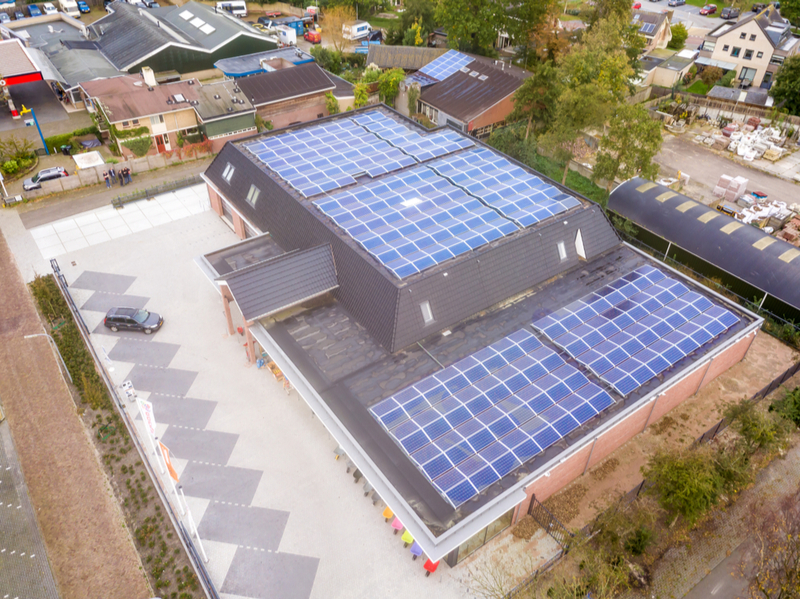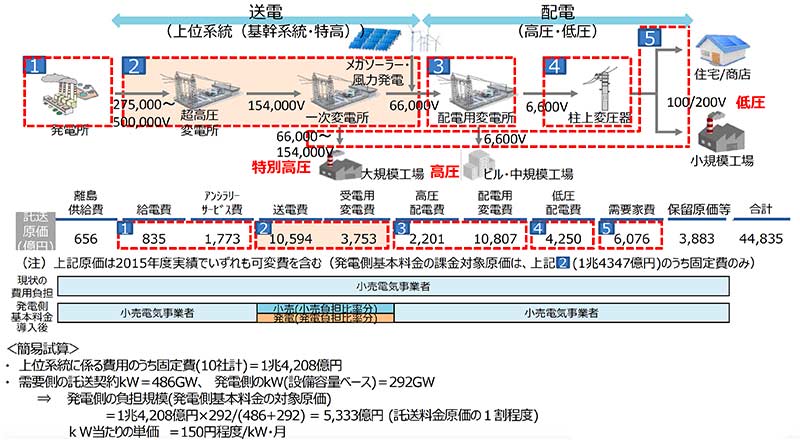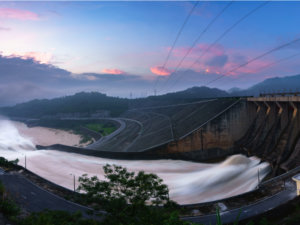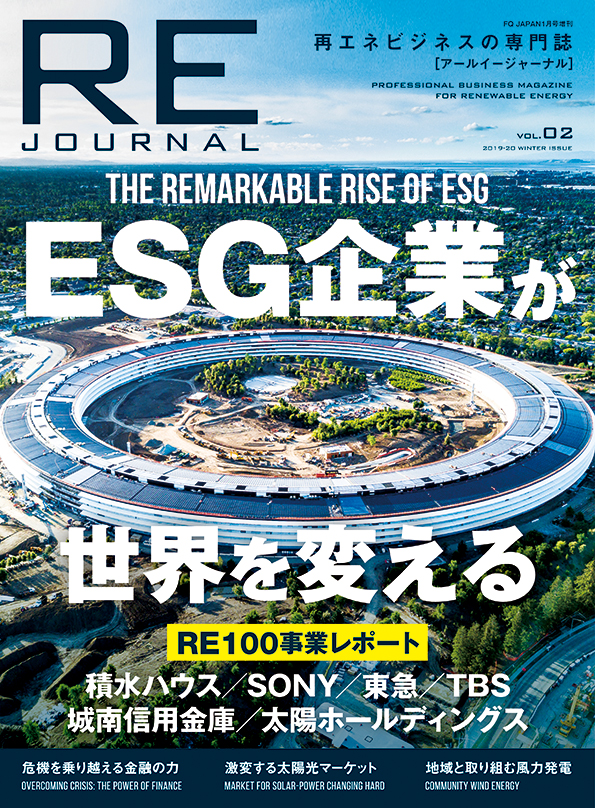太陽光マーケットは、発電側基本料金の導入と廃棄費用積立の義務化へ
2020/11/02

FITからFIPへの転換、発電側基本料金など、激変する日本の太陽光マーケットにこれから訪れる変化を展望する。発電側基本料金の導入と廃棄費用積立の義務化によって、制度がどのように変わるのだろうか。
発電側課金が23年度から導入
稼働済み太陽光の措置で混乱
経済産業省は送配電系統網の託送料金制度見直しの一つである発電側基本料金制度の詳細検討に着手している。2023年度の導入を目指している。ただ、FIT認定の稼働済み太陽光発電所の問題など、さまざまな懸念事項が生じている。
発電側基本料金とは、系統を利用することで得られる受益の一部を発電設備設置者からも課金する新制度だ。発電側基本料金の導入は、2018年7月に閣議決定されている。発電側と需要側の両方で等しく受益していると考えられる、超高圧変電所や一次変電所などを含めた上位系統にかかる費用のうちの固定費について、すでに運転している発電所も今後開発する発電所も一定割合を負担することになる(図1)。発電側全体の具体的な負担額は託送料金原価の1割程度にあたる約5300億円だ。原子力発電、石炭火力、太陽光発電など電源種にかかわらず1kW当たり毎月150円程度で年間1800円をメドに支払うようになる。
発電側基本料金は、稼働済み・認定済みのFIT太陽光発電所の取り扱いで太陽光発電業界関係者から批判が出ている。FIT太陽光発電所は売電価格が固定されており、太陽光発電事業者は発電側課金による追加負担を転嫁できない。発電側基本料金導入を閣議決定した2018年7月当初は、稼働済み・認定済みFIT太陽光発電所にはすべて緩和措置をとる方針だった。
しかし、2019年8月に経済産業省の再生可能エネルギー大量導入・次世代電力ネットワーク小委員会がまとめた第3次中間整理では従来方針を手のひら返しして、稼働済み・認定済みFIT太陽光発電所のうち、利潤配慮期間には緩和措置を不要とする方針を打ち出した。利潤配慮期間とは、2012年7月のFIT開始から3年間にあたる買取価格を高めに設定してきた期間だ。具体的には2012年の40円/kWh(税抜き)、2013年の36円、2014年の32円、2015年6月末までの29円の太陽光発電が対象だ。
kW当たり月150円の基本料金を太陽光発電の発電効率に換算すると、kWh当たり1.4~1.7円の負担になるという。つまり従来40円/kWhで売電した買取価格が38.3~38.6円に減額されることとなる。再生可能エネルギー関連法務に精通している弁護士や太陽光発電事業者は、「太陽光発電の比率がまだ低い状況にあるなか、太陽光発電投資への逆インセンティブとなる施策を先行導入することは、自立化への芽を摘むリスクになる。しかも過去にさかのぼって制度変更するのは国の信用力を著しく下げる。海外投資家の日本への投資を懐疑的にする」と指摘する。発電側課金は導入される方針だが、太陽光発電の利潤配慮期間の緩和措置はどうなるかは大きな焦点となっている。
図1:発電側基本料金の対象費用イメージ

※注 簡易な試算であることに加え、事業者によって送配電関連費用の構成や料金算定の根拠となる発電側及び需要側のkW 構成等が異なるため、実際の負担水準は異なる可能性がある点に留意する必要がある。
出典:経済産業省資料
廃棄費用積立を義務化へ
条件満たせば内部積立も容認
FITの抜本見直しの一環で、太陽光発電設備の廃棄費用積み立ては義務化される。災害などで使えなくなった太陽光発電設備が放置・不法投棄されるケースが多発し社会問題化しているからだ。将来、事業用の買取期間満了が発生する2032年以降には大量の太陽光発電設備が放置・不法投棄されることになるのでないかとの懸念が出ている。
もともと、FITの買取価格には廃棄費用も計上しており、2018年4月には積み立てを努力義務として課したが、積み立ての実施率が低いことが判明。経済産業省は対応策を検討した。原則として「費用負担調整機関」が源泉徴収的に積み立てを行う方法により「外部積立」を求める、さらに長期安定発電の責任・能力を担うことが可能と認められる事業者に対しては内部積立を認めることになる。
廃棄費用積み立て制度の適用対象は、稼働・未稼働を問わず、FIT開始以降に認定を受けた10kW以上すべての太陽光発電とした。一方、積み立て金額は、2019年度末までの認定案件は、買取価格の算定で想定した廃棄費用とし、2020年度以降分は調達価格算定委員会で定める。入札案件は2019年度までは最低落札価格を基準に調整、2020年度以降は算定委が定めた額とする。積み立て期間は一律「買取期間の終了前10年間」とし、毎月積み立てる。
買取期間終了後も発電事業を継続する場合は、事業の継続過程で太陽光発電の一部を交換・廃棄するような場合に別途定める条件を満たせば積み立て金の取り戻しを認めることになった。
また、FITの後継制度にも同様に適用される。廃棄費用積み立て制度は周知期間を考慮し、2022年7月までの適切な時期に施行する予定だ。
Generator-side billing system to be introduced in FY2023 A confusion arising for the operating solar plants
METI has embarked on detailing out the generator-side base charge system, as part of the revisions to be made to current wheeling charges for power grid. The plan is to introduce the proposed change in FY2023. However, various concerns have arisen, including how to apply this change to FIT-approved solar power plants that are currently under operation. The generator-side base charge is a new system in which the installers of power plants can also charge a portion in order to compensate the benefits generated by using the grid. The introduction of this system has been approved by the Cabinet in July 2018. Both operating power plants and future power plants will pay a certain price in order to cover fixed costs that are part of the total cost to maintain the upper transmission system that benefits both producers and consumers; this will include super high voltage substations and primary substations (Fig. 3). The total amount the generator-side will bear is approximately 10% of the unit wheeling charges, which is about 530 billion yen. Whether it is nuclear, coal-fired, or solar origin, the generators will pay about 150 yen per kW per month, which translates to about 1,800 Yen per year per kW. Some experts in the solar power industry criticize this new charge rule with regard to the way it proposes handling solar plants that are FIT approved and in operation. FIT-approved solar power plants have a fixed sell prices, thus producers cannot transfer the burden born by the new rule. In the beginning of July 2018 when the Cabinet passed the introduction of generator-side base charge, the plan was to apply some relief measures for all the operating FIT solar power plants. However, in August 2019 the Subcommittee for Introducing Large Amount of Renewable Energy and Next-generation Power Network under METI published its 3rd interim report, which included a 180-degree turn from the previous plan, stating that relief measures should not be applicable for the “profit incentive period” of the approved and operating FIT solar projects. The “profit incentive period” is a three-year period since the launch of the FIT system in July 2012, during which the purchase price was set higher. Specifically, it refers to the plants that were entitled to: 40 Yen/kWh (excluding tax) in 2012, 36 Yen/kW in 2013, 32 Yen/kW in 2014, and 29 Yen/kW by the end of June 2015. When considering the base charges of 150 Yen/kW/month in solar power terms, it translates to a cost increase of 1.4 to 1.7 Yen /kWh. This means that solar power previously sold at 40 Yen/kWh will be reduced to 38.3 to 38.6 Yen/kWh. Lawyers and solar power generators who are experts in renewable energy-related legal affairs express their concerns: “Solar energy occupies a small ratio of our energy supply portfolio. It is risky to introduce such a disincentive at this point of time, which will discourage investments in solar power generation. It would prevent solar power from growing to a stable source. In addition, such retroactive adjustments to the existing system will significantly lower the credibility of the country, making foreign investors skeptical about investing in Japan.” The introduction of generator-side base charges is confirmed, but the decisions on the relief measure for solar plants’ profit consideration period is a major issue that should be monitored carefully.
Mandating a disposal fee deposit Internal deposit is permitted if conditions are met
As part of the fundamental revision to the current FIT policy, a new obligation will be introduced to fund disposal costs associated with solar power facilities. This new rule is in response to the concern that damaged solar power equipment which is no longer usable due to, for example, disaster events is abandoned or illegally dumped, creating a new social problem. Once the purchase of commercial solar expires in 2032, it is greatly concerned that a large amount of solar-related waste will be generated, most of which will end up abandoned or illegally dumped. While the FIT purchase price takes into account disposal costs, and while there is a mandate since April 2018 requiring efforts to secure disposal costs, the review found that few entities have put this into practice. METI, therefore, decided to develop a follow-up measure. As a general rule, companies are mandated to fund externally the disposal cost through a coordinating institution which will be in charge of collecting such fees in a form similar to the tax withholding system. Where a generator is deemed responsible and capable of supplying stable solar power for a long period of time, it may be permitted to fund the cost internally. The scope of this new obligation is all photovoltaic power generation systems with more than 10 kW capacity that have been approved since the start of FIT. This is regardless of whether the plants are in operation or not. In terms of the amount, for those facilities that have been approved by the end of FY2019, it should be calculated based on the assumed purchase price, and for those after FY2020 the amount will be determined by the Procurement Price Calculation Committee. Bidding projects until the end of FY2019 will be adjusted based on the lowest winning bid, and for the projects after FY2020, it will be determined by the said committee. The deposit must be made monthly to accumulate for “10 years before the end of the purchase period”. If a company decides to continue a power generation business after the end of the purchase period, in which case it may involve replacing or repairing some parts of the solar system, the company may be granted access to the fund provided that several conditions specified separately are met. The same will apply to the proposed new scheme. The new requirement on disposal costs will come into force sometime before July 2022, ensuring sufficient time to inform the applicable entities.
取材・文/南野彰
RE JOURNAL vol.2(2019-20年冬号)より転載












